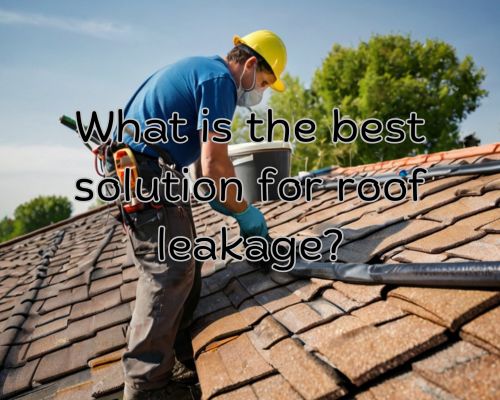
Expert Advice and Top Fixes
Roof leakage is a common issue that can lead to significant property damage if not addressed promptly.
The best solution for roof leakage often involves identifying the source of the leak and selecting the appropriate sealant or repair method.

Depending on the severity of the leak, products like Dicor Self-Leveling Lap Sealant for general leaks, Liquid Rubber Waterproof Sealant for large leaks, and Gorilla Waterproof Patch & Seal Tape for quick fixes are highly recommended.
You might wonder why addressing roof leaks is so critical. Ignoring these leaks can lead to water damage, mold growth, and structural deterioration.
The most common causes of roof leaks include damaged or missing shingles, cracked flashing, and clogged gutters, which allow water to seep into your home.
Finding the source of a roof leak involves inspecting areas like ceilings, walls, the attic, and the roof itself for water stains or wet spots.
Using a garden hose can help isolate the problem area by soaking sections adjacent to where the leak manifests.
This practical approach ensures that you can apply the right fix and prevent future occurrences effectively. Let us get to know more with Charles Jimerson from CJ Commercial Roofing NJ.
Identifying and Addressing Common Leak Sources
Determining the source of a roof leak and taking appropriate action is crucial for maintaining a secure and watertight roof. With Charles Jimerson from CJ Commercial Roofing NJ, we will be inspecting for signs of leaks, identifying common culprits, and effective repair techniques.
Inspecting for Signs of Leaks
Begin by checking for obvious signs like water stains and peeling paint on your ceiling.
Also, look for mold and moisture in your attic.
Daylight peeking through the roof can indicate holes.
Use a flashlight to spot wet spots or trails of moisture on rafters and sheathing. These indicators can lead you to the source of the leak.
It’s also advisable to perform regular roof inspections, especially after heavy rains, to identify potential issues early.
Common Culprits of Leakage
Roof leaks often stem from several common problem areas.
Damaged or missing shingles are frequent causes, as are clogged gutters which can lead to water overflow.
Flashing around chimneys, vents, and skylights can deteriorate over time, creating pathways for water ingress. Check step flashing and valley flashing for rust or gaps.
Flat roofs may suffer from pooling water, while shingle roofs can be affected by wind damage. Metal roofs might develop leaks at joints or screws.
Repair Techniques for Various Roof Types
For shingle roofs, replace damaged or missing shingles promptly.
Use roofing cement to seal small gaps and cracks.
In cases of damaged flashing, remove the old flashing and install new ones, ensuring a watertight seal.
On metal roofs, tighten or replace screws and use rubberized sealant for cracks.
For holes, metal patches can be used for lasting repairs.
Flat roofs often require rubber patches.
Apply a generous amount of roof sealant over the patch to ensure it adheres properly.
Maintain regular gutter cleaning to prevent water buildup and check for issues after any severe weather conditions.
In more complex cases, consider hiring a roofing contractor to ensure repairs are done correctly and safely.
Always prioritize safety by using proper equipment and taking necessary precautions when inspecting or repairing your roof.
Preventive Measures and Long-Term Solutions
Ensuring the longevity and effectiveness of your roof involves consistent maintenance, making informed choices on materials, and deciding whether to tackle repairs yourself or hire professionals.
Routine Maintenance and Inspection
Regular Roof Inspections are crucial in identifying potential issues before they turn into major problems.
Schedule inspections at least twice a year, preferably during spring and fall. Extreme weather and storms can cause unforeseen damage, so inspect after such events as well.
Clear Debris from your roof and gutters to prevent water pooling, which can cause leaks and water damage.
This includes removing leaves, branches, and dirt, ensuring proper water flow.
Check for Mold Growth, especially in humid regions. Mold not only damages your roof structure but also poses health risks.
Choosing the Right Materials and Methods
Selecting the appropriate roofing materials impacts the roof’s longevity and effectiveness.
Slate tiles can last over 50 years, while asphalt shingles may need replacement after 15 years. Consider your budget and long-term needs.
Implement proper insulation and ventilation methods.
Roof vents play a crucial role in maintaining air flow, which prevents moisture build-up and prolongs roof life.
Sealants help waterproof your roof.
Opt for quality urethane sealant, water-based sealant, or solvent-based sealants.
Liquid rubber waterproof sealants, like Rubberseal, are effective in creating a watertight barrier, preventing leaks efficiently.
Professional Repair vs. DIY
Professional Roofers bring expertise, safety, and value to the repair process. They are equipped to handle complex repairs and ensure long-lasting solutions. However, their services come at a higher cost.
Engaging a roofing professional is advisable for extensive projects or roofing materials that require specific application techniques.
DIY Repairs can be budget-friendly and suitable for minor fixes like sealing small leaks with caulk or roof sealant. Ensure you have the right tools and safety measures in place. For DIYers, using clear tutorials and understanding your roof’s structure is key to effective repairs.
Balancing professional help and DIY efforts can optimize cost and efficiency, giving you a durable, well-maintained roof.





